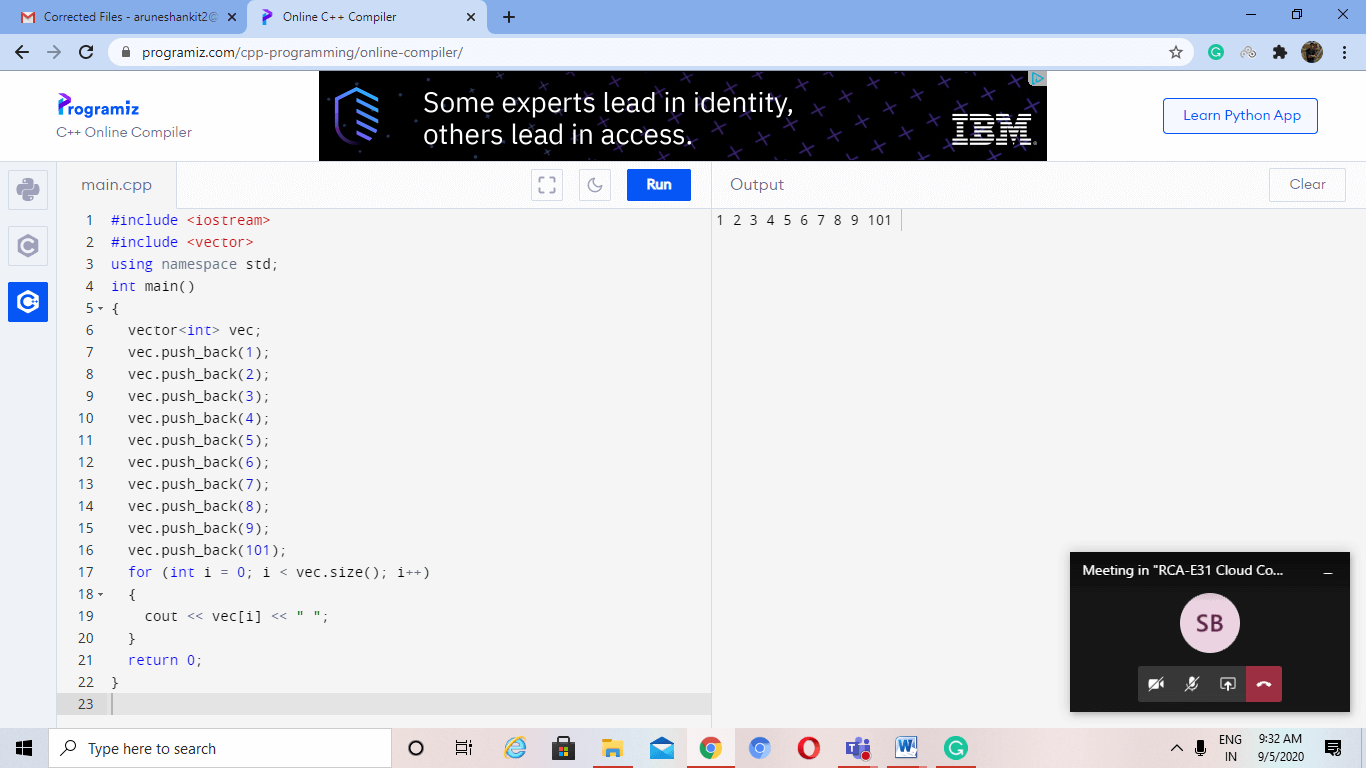- 基础教程
- 条件语句
- 指针教程
- 面向对象
- STL教程
- 进阶教程

向量可以存储多个数据值(例如数组),但它们只能存储对象引用,而不能存储原始数据类型。它们存储对象的引用,意味着它们指向包含数据的对象,而不是存储它们。与数组不同,向量不必使用大小初始化。它们具有根据对象引用数进行调整的灵活性,这是可能的,因为它们的存储由集合自动处理。集合将保留alloc的内部副本,该副本用于分配生命周期的存储。可以使用迭代器定位和遍历向量,因此将它们放置在连续的存储中。与Array不同,Vector还具有安全函数,可以防止程序崩溃。我们可以给向量保留空间,但不能给数组留空间。数组不是类,而向量是类。在vector中,可以删除元素,但不能删除数组中的元素。
有四种方法可以在C++中初始化向量:
- 通过一对一输入值
- 使用向量类的重载构造函数
- 借助数组
- 通过使用另一个初始化的向量
通过push_back
使用向量类方法" push_back"可以一个向量地插入向量中的所有元素。
Begin Declare v of vector type. Then we call push_back() function. This is done to insert values into vector v. Then we print "Vector elements: \n". " for (int a: v) print all the elements of variable a."
代码-
#include <iostream> #include <vector> using namespace std; int main() { vector<int> vec; vec.push_back(1); vec.push_back(2); vec.push_back(3); vec.push_back(4); vec.push_back(5); vec.push_back(6); vec.push_back(7); vec.push_back(8); vec.push_back(9); vec.push_back(101); for (int i = 0; i < vec.size(); i++) { cout << vec[i] << " "; } return 0; }
输出

使用重载构造函数-
当一个向量具有多个具有相同值的元素时,则使用此方法。通过使用vector类的重载构造函数-
此方法主要在向量填充具有相同值的多个元素时使用。
算法
Begin First, we initialize a variable say 's'. Then we have to create a vector say 'v' with size's'. Then we initialize vector v1. Then initialize v2 by v1. Then we print the elements. End.
代码-
#include <iostream> #include <vector> using namespace std; int main() { int elements = 12; vector<int> vec(elements, 8); for (int i = 0; i < vec.size(); i++) { cout << vec[i] << " \n"; } return 0; }
输出
8 8 8 8 8 8 8 8 8 8 8 8
通过数组
我们将数组传递给vector类的构造函数。数组包含将填充矢量的元素。
算法-
Begin First, we create a vector say v. Then, we initialize the vector. In the end, print the elements. End.
代码-
#include <iostream> #include <vector> using namespace std; int main() { vector<int> vectr{9,8,7,6,5,4,3,2,1,0}; for (int i = 0; i < vectr.size(); i++) { cout << vectr[i] << " \n"; } return 0; }
输出
9 8 7 6 5 4 3 2 1 0
使用另一个初始化向量-
在这里,我们必须将初始化向量的begin()和end()迭代器传递给向量类构造函数。然后,我们初始化一个新向量,并用旧向量填充它。
算法-
Begin First, we have to create a vector v1. Then, we have to initialize vector v1 by an array. Then we initialize vector v2 by v1. We have to print the elements. End.
代码-
#include <iostream> #include <vector> using namespace std; int main() { vector<int> vec_1{1,2,3,4,5,6,7,8}; vector<int> vec_2(vec_1.begin(), vec_1.end()); for (int i = 0; i < vec_2.size(); i++) { cout << vec_2[i] << " \n"; } return 0; }
输出
1 2 3 4 5 6 7 8
祝学习愉快!(内容编辑有误?请选中要编辑内容 -> 右键 -> 修改 -> 提交!)
 《C++入门教程》
《C++入门教程》 